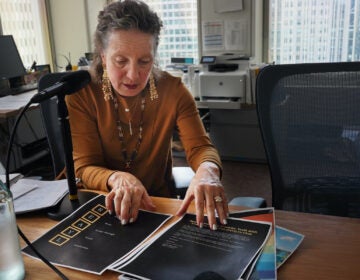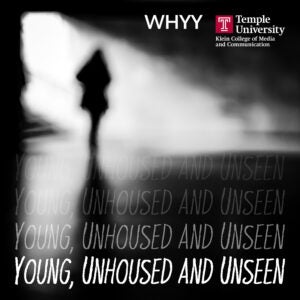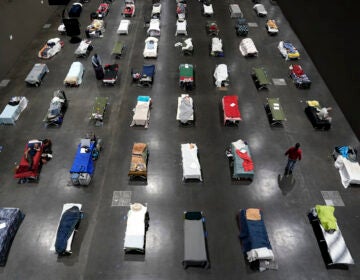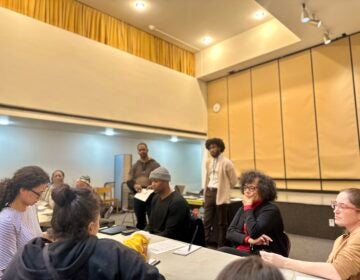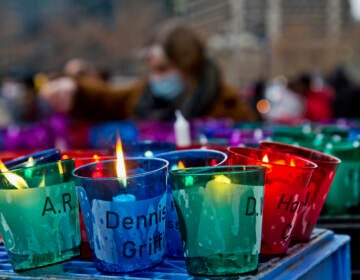WHYY News, Logan Center launch project examining youth homelessness
The five-part podcast series examines youth homelessness in Philadelphia and explores solutions to end a largely invisible plight for thousands of the city’s young people.
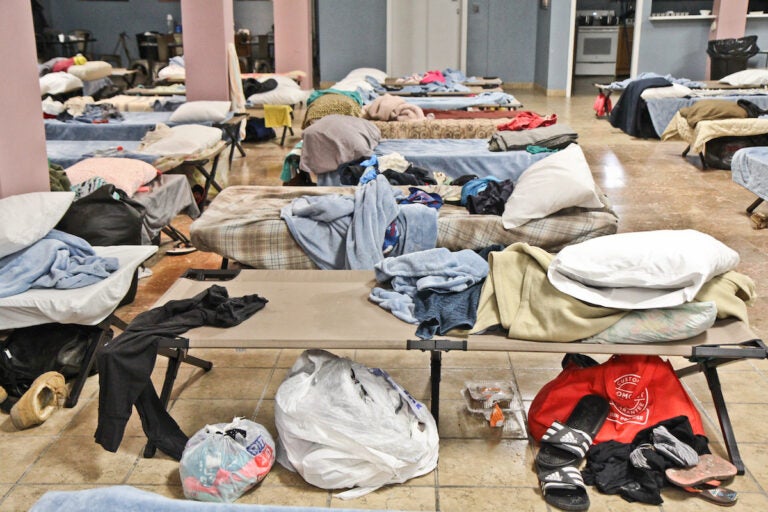
This temporary shelter was created by Prevention Point in Kensington in 2018 after encampments were cleared. (Kimberly Paynter/WHYY)
This story is from Young, Unhoused and Unseen, a podcast production from WHYY News and Temple University’s Logan Center for Urban Investigative Reporting.
Find it on Apple Podcasts, Spotify, or wherever you get your podcasts.
Jayda Alexander was raised by a mother who she said abused her.
She lived in group homes, moved in with relatives, couch surfed, and wound up in a toxic relationship. It seemed like everything she tried to keep her life together failed.
“A lot of stuff could have really broke me,” Alexander, now 23, said. “I could have died a million times in my life.”
Without help from family or friends, Alexander said she decided to turn to help from the city’s resources. She applied for public housing specifically intended for young people, and was approved for a home soon after.
“People always doubted me, and I started to doubt myself,” Alexander said. “But once I figured out, ‘You know, like, Jayda, you really could do it on your own,’ I did it on my own.”
Alexander’s story is not uncommon in Philadelphia: Thousands of youth and young adults in the city face homelessness. The vast majority are Black or Hispanic, and a third are pregnant or parenting, according to a report released by the Office of Homeless Services in April.
That report, in addition to shedding light on the scale of the youth homelessness epidemic, will serve as a key piece of the city’s plan to distribute roughly $8.8 million in funds the U.S. Department of Housing and Urban Development awarded to Philadelphia last year.
Alexander — now married, a mom of two, and working as a case worker for a local nonprofit while attending college — is co-chair of the Office of Homeless Services’ Young Adult Leadership Committee, a group of unhoused and formerly unhoused young adults who helped write the report.
The 72-page document charts an ambitious goal: To make youth homelessness “rare, brief, and non-recurring.”
But amid ever-rising housing prices, a minimum hourly wage of just $7.25, and Philadelphia counting the greatest share of its residents in poverty compared to the nation’s largest cities, will this plan be enough to curb the epidemic?
WHYY News and Temple University, Klein College’s Logan Center for Urban Investigative Reporting are publishing a five-part weekly podcast series “Young, Unhoused and Unseen,” which examines the tragedy of youth homelessness in Philadelphia and explores solutions to end a largely invisible plight for thousands of the city’s teens and young adults.
The multimedia project features additional reporting with storylines across the region, social media, and data visualizations.
The podcast features the stories of homeless teens in group homes, young moms in shelters, those identifying as LGBTQ, and youth in a suburban homeless encampment. The podcast also brings context and commentary from community leaders and local and national experts into the discussion.
Unhoused young people, particularly those aged 18 to 24, face unique challenges. Many fell into homelessness after aging out of foster care, or sought to escape family abuse or rejection of their gender or sexual identity, according to the city’s report. Others couldn’t make enough money to support themselves.
In Philadelphia, the city provided housing services, such as emergency shelters, to nearly 1,600 young adults experiencing homelessness last fiscal year, according to the report. Experts say others don’t show up in the data because they seek informal help, such as couch surfing with friends, or cannot access services due to mental health issues or other disabilities.
Liz Hersh, the former director of the Office of Homeless Services, oversaw the grant process and remains hopeful that youth homelessness can be solved, especially as the city has tailored more services to young adults.
“Young people are still very resilient, they’re very hopeful,” Hersh said. “And so it’s really trying to capitalize on all of those positives, help them deal with their trauma while they’re still developing, so that those things, those hurts and pains and setbacks and challenges, don’t become solidified into them as adults, but that they’re able to really rewrite their future history to have a different kind of life.”
A data problem
Counting youth experiencing homelessness is an immense challenge. The stigmas around homelessness, invisibility of those who couch surf or “double up” in shared, temporary housing, and intersection between homelessness and incarceration lead to frequent undercounts, making it more difficult to provide services.
The difficulty in simply assessing the number of youth who are without housing is, according to Alexia Clarke, the CEO of Covenant House Pennsylvania, due to a combination of factors. Her organization provides shelter and rapid rehousing to youth experiencing homelessness.
“The transient nature of the population, their protective distrust of systems, and the variation in what constitutes homelessness makes it tough to get accurate counts,” she said. “Limited resources for data collection also leads to underreporting. We’ve got to put in serious effort into outreach, for example, to connect with young people affected by homelessness effectively.”
The federal government’s method for counting people experiencing homelessness — and, consequently, distributing funding — is an annual “Point In Time” count of all people residing on the streets and in shelters on a single day during the year.
This year’s Point In Time count, conducted on Jan. 25, identified 368 youth experiencing homelessness aged 18 to 24. That’s far lower than the 1,574 young adults documented by the city’s homeless services in 2022.
The Point In Time count likely leaves out youth who are couch surfing, and weather can affect the number of people who are out on the streets from night to night, said David Fair, the deputy chief executive officer of Turning Points For Children and co-chair of Philly Homes 4 Youth.
“The point in time count is, I think, a really good model, but it can only be useful if it’s done frequently,” Fair said. “Having one point in time a year is not going to get you an accurate picture of the homeless population in Philadelphia.”
Guns impact homeless youth
The challenges of youth homelessness are further exacerbated by its frequent intersection with gun violence, making an already difficult situation even more complex and dangerous for young people without stable housing.
Philadelphia recorded a record 562 homicides in 2021, and the vast majority were committed using guns. Though murders have declined since then, guns have killed 348 people and injured 1,216 others so far in 2023.
More than a third shot this year were younger than 25. The hotspots for gun violence include the city’s most impoverished neighborhoods.
Clarke explained that Covenant House struggles with serving unhoused youth who are also impacted by gun violence.
“In addition to questions of utilizing weapons to create safety for themselves, young folks are experiencing trauma from being exposed to gun violence,” she said. “Evidence has long shown that trauma is the vector of gun violence, so to effectively end that violence, we need to first create safety and second, treat the trauma.”
A national survey of nearly 1,500 young adults experiencing homelessness found two thirds had witnessed gun violence, or themselves had been victims. In addition, nearly 18% were perpetrators, according to the 2021 study in the American Journal of Preventive Medicine.
Shirlana Dash, the chief executive officer of SELF Inc., a provider of emergency and permanent housing, said young people without stable family environments or strong communities are more susceptible to being drawn into criminality by social media or the people around them.
“Of course not every homeless person, or every young person is, of course, a criminal,” Dash said. “But the correlation is if I don’t have those strong structures in place, and that stability, then I’m more amenable to other things that provide quick money, quick status for young people.”
Success means ‘exiting the homeless system’
Many proposals aimed at curbing youth homelessness involve increasing access to affordable housing and social services.
Mirroring national trends, affording a home has gotten more difficult in Philadelphia as median housing prices have increased by 26% over the past five years, according to Redfin. The homeowner vacancy rate was an estimated 1.2% on average from 2017 through 2021, according to the U.S. Census Bureau. This falls below the target of 2% that many experts say indicates a healthy housing market.
Renting presents significant challenges for numerous residents, as more than half allocate more than 30% of their income to rent. This expenditure level is classified as “cost-burdened” by the Census Bureau, and it indicates a substantial financial strain.
With the $8.78 million grant, the Office of Homeless Services plans to fund 246 new housing units that will serve 281 youth and young adults with the priority on building so-called “rapid rehousing,” which helps people secure permanent housing and temporary rental assistance and support services.
The other units will include transitional housing, as well as permanent supportive housing intended for young people with mental health struggles, substance abuse disorders, and communicable diseases, according to the city’s report.
“What success looks like to us is … exiting the homeless system and not coming back, increasing your income,” Hersh said. “And then for the next generation, that they have a better shot, that they don’t become homeless.”
Some grassroots providers are choosing not to apply for a share of the funds. Tatyana Woodard is the executive director of North Philly’s Ark of Safety, the city’s only LGBTQ shelter. Between 25% and 40% of the city’s homeless youth identify as LGBTQ, according to the city’s report.
Woodard said her organization, which reserves some beds specifically for trans people, wants to avoid grants that may limit how they can operate. Ark of Safety has received support from Next Level Revival Church and private donors via a GoFundMe, she added.
“With things like that comes a lot of restrictions. We know our people. We know our needs,” Woodard said in the podcast. “All money ain’t good money.”
For young adults like Rachel, 22, who did not want to share her last name, change couldn’t come sooner. After her and her fiance lost their housing during the COVID-19 pandemic, they spent a few years living on the streets, in hotels, and with friends until they were able to move themselves and their young son into an emergency shelter in North Philly.
Still, she has conflicts with the shelter’s staff, and there are vermin infestations, so Rachel wants to find new housing soon, she said.
Sitting with her son in Love Park, she said she finds happiness in watching him enjoy the water.
“I want to live a mediocre life,” Rachel said in the podcast. “I don’t expect nothing too, you know, extravagant. I just personally want a mediocre life. So that’s my happiness at the end of that.”
P. Kenneth Burns contributed reporting to this story.

Get daily updates from WHYY News!
WHYY is your source for fact-based, in-depth journalism and information. As a nonprofit organization, we rely on financial support from readers like you. Please give today.


